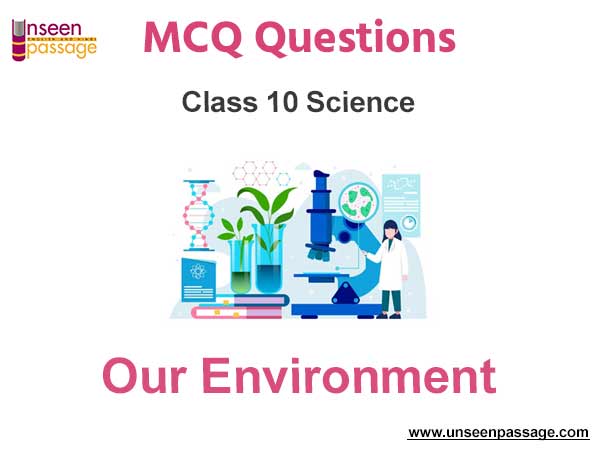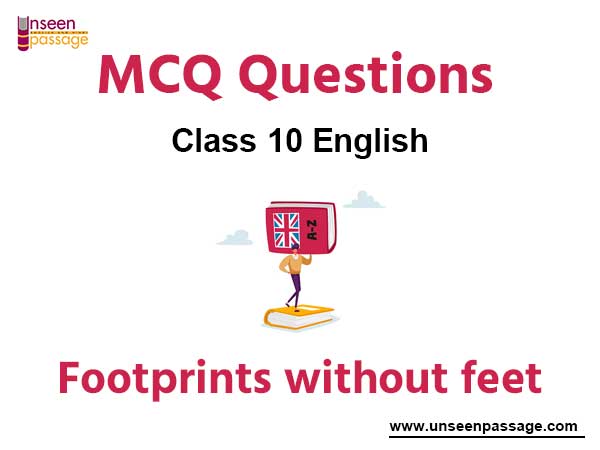Our Environment MCQ Class 10 Science
Please refer to Chapter 15 Our Environment MCQ Class 10 Science with answers below. These multiple-choice questions have been prepared based on the latest NCERT book for Class 10 Science. Students should refer to MCQ Questions for Class 10 Science with Answers to score more marks in Grade 10 Science exams. Students should read the chapter Our Environment and then attempt the following objective questions.
MCQ Questions Class 10 Science Chapter 15 Our Environment
The Our Environment MCQ Class 10 Science provided below covers all important topics given in this chapter. These MCQs will help you to properly prepare for exams.
Question. A food chain comprising birds, green plants, fish and man. The concentration of harmful chemical entering the food chain will be maximum in
(a) green plants
(b) man
(c) birds
(d) fish
Answer
B
Question. Assertion: Ozone layer is getting depleted at upper atmosphere which is a cause of concern.
Reason: CFC reacts with ozone and breaks it.
(a) Both A and R are true and R is the correct explanation of A.
(b) Both A and R are true but R is not the correct explanation of A.
(c) A is true but R is false.
(d) A is false but R is true.
(e) Both A and R are false.
Answer
A
Question. Which of the following is an abiotic component of an ecosystem?
(a) Humus
(b) Bacteria
(c) Plants
(d) Fungi
Answer
A
Question. Excessive exposure to ultraviolet radiation causes
(a) inflammation of liver
(b) cancer of skin
(c) damage to the lungs
(d) jaundice
Answer
B
Question. What will happen if all the deer are killed in the given food chain?
Grass → Deer → Lion
(a) The population of grass decreases.
(b) The population of lions increases.
(c) The population of lions remains unchanged.
(d) The population of lions decreases and grass increases.
Answer
D
Question. Which of the following is biodegradable?
(a) Plastic mugs
(b) Leather belts
(c) Silver foil
(d) Iron nails
Answer
B
Question. Which of the following is non- biodegradable?
(a) Wool
(b) Nylon
(c) Animal bones
(d) Tea leaves
Answer
B
Question. Which of the following is an autotroph?
(a) Lion
(b) Insect
(c) Tree
(d) Mushroom
Answer
C
Question. Which of the following is a logical sequence of food chain
(a) producer → consumer → decomposer
(b) producer → decomposer → consumer
(c) consumer → producer → decomposer
(d) decomposer → producer → consumer
Answer
A
Question. A food chain always starts with
(a) respiration
(b) photosynthesis
(c) decay
(d) nitrogen fixation
Answer
B
Question. Ozone layer is damaged by-
(a) methane
(b) carbon-dioxide
(c) Sulphur-dioxide
(d) CFCs
Answer
D
Question. Which of the following is not a terrestrial ecosystem-
(a) forest
(b) desert
(c) aquarium
(d) grassland
Answer
C
Question. Which of the following limits the number of trophic levels in a food chain?
(a) water
(b) polluted air
(c) deficient food supply
(d) decrease in energy at higher trophic levels
Answer
D
Question. In the garden ecosystem, which of the following are producers?
(a) Insects
(b) Snakes
(c) Grasses
(d) Rabbits
Answer
C
Question. Assertion: Biodegradable waste and non biodegradable waste should be discarded separately,
Reason: Biodegradable waste are not harmful.
(b) Both A and R are true but R is not the correct explanation of A.
(c) A is true but R is false.
(d) A is false but R is true.
(e) Both A and R are false.
Answer
C
Question. In an ecosystem, herbivores represent
(a) producers
(b) primary consumers
(c) secondary consumers
(d) decomposers
Answer
B
Question. First link in any food chain is usually green plants because
(a) they are widely distributed
(b) they are fixed at one place in the soil
(c) they alone have the capacity to synthesise food using sunlight
(d) there are more herbivores than carnivores
Answer
C
Question. Flow of energy in an ecosystem is always-
(a) unidirectional
(b) bidirectional
(c) multidirectional
(d) no specific direction.
Answer
A
Question. Which one of the following will undergo fastest bio-degradation?
(a) Mango seed
(b) Wood
(c) Mango peel
(d) Mango pulp
Answer
D
Question. The depletion of the ozone layer causes
(a) global wanning
(b) earthquakes
(c) increased UV radiations
(d) acid rain
Answer
C
Question. Assertion: Vegetarian food habit is more beneficial to organisms.
Reason: Only 10% energy is available as food from one trophic level to next.
(a) Both A and R are true and R is the correct explanation of A.
(b) Both A and R are true but R is not the correct explanation of A.
(c) A is true but R is false.
(d) A is false but R is true.
(e) Both A and R are false.
Answer
A
Question. Which of the following is biodegradable?
(a) Aluminium can
(b) Polythene bag
(c) Cowdung
(d) DDT
Answer
C
Question. The ecosystem of earth is known as-
(a) biome
(b) community
(c) biosphere
(c) association
Answer
C
Question. In natural ecosystems, decomposers include-
(a) only bacteria and fungi
(b) only microscopic animals
(c) herbivores and carnivores
(d) both (b) and (c)
Answer
A
Question. Which of the following is non-biodegradable-
(a) paper
(b) wood
(c) cloth
(d) plastic
Answer
D
Question. The percentage of solar radiation absorbed by all the green plants for the process of photosynthesis is about-
(a) 1%
(b) 8%
(c) 5%
(d) 10%
Answer
A
Question. Which of the two in the following sets belong to the same trophic level?
(a) Grass : Grasshopper
(b) Goat : Spider
(c) Hawk : Rat
(d) Frog : Lizard
Answer
D
Question. Acid rain is caused by the oxides of
(a) carbon
(b) nitrogen only
(c) sulphur only
(d) sulphur and nitrogen
Answer
D
Question. The second trophic level is always of-
(a) herbivores
(b) autotrophs
(c) carnivores
(c) producers
Answer
A
Question. Trophic level in an ecosystem represents
(a) oxygen level
(b) water level
(c) energy level
(d) salt level
Answer
C
Question. Which one of the following pairs belong to the category of primary consumers?
(a) Eagle and snake
(b) Grasshoppers & cattle
(c) Snake and frog
(d) Water beetles & fish
Answer
B
Question. The decomposers in an ecosystem-
(a) convert organic material to inorganic forms
(b) convert inorganic material to simpler forms
(c) convert inorganic material into organic compound
(d) do not break down organic compound
Answer
A
Question. How much of the net primary productivity of a terrestrial ecosystem is eaten and digested by herbivores?
(a) 100%
(b) 10%
(c) 1%
(d) 0.1%
Answer
B
Question. Expand the abbreviation GAP:
(a) Governmental Agency for Pollution Control
(b) Gross Assimilation by Photosynthesis
(c) Ganga Action Plan
(d) Governmental Agency for Animal Protection
Answer
C
Question. The flow of energy in an ecosystem is always:
(a) unidirectional
(b) bidirectional
(c) multidirectional
(d) no specific direction
Answer
A
Question. Which of the following are biodegradable substances?
(a) Glass bottole, Grass
(b) Jutebag, polythene bag
(c) Cotton cloth, vegetable peels
(d) DDT, Pen refill
Answer
C
Question. Which of the following limits the number of trophic levels in a food chain?
(a) Decrease in energy at higher trophic levels
(b) Deficient food supply
(c) Polluted air
(d) Water
Answer
A
Question. The percentage of solar radiation absorbed by all the green plants for the process of photosynthesis is about:
(a) 1%
(b) 5%
(c) 8%
(d) 10%
Answer
A
Question. In the given figure, the various trophic levels are shown in a pyramid. At which trophic level is maximum energy available?

(a) T4
(b) T2
(c) T1
(d) T3
Answer
C
Question. The decomposers in an ecosystem:
(a) convert inorganic material to simpler forms
(b) convert organic material to inorganic forms
(c) convert inorganic material to organic compounds
(d) do not breakdown organic compounds
Answer
B
Question. Which of the statement is incorrect?
(a) Producers form the first prophic level.
(b) Produces trap solor energy and transform it into chemical energy in food.
(c) All plants are producers.
(d) Nutrients and energy enter the living world through producers.
Answer
C
Question. If a grasshopper is eaten by a frog, then the energy transfer will be from:
(a) producer to decomposer
(b) producer to primary consumer
(c) primary consumer to secondary consumer
(d) secondary consumer to primary consumer
Answer
C
Assertion-Reason Questions
In each of following questions, a statemant of
Assertion (A) is given followed by a corresponding statement of Reason (R). Select the correct answer to codes (a), (b) (c) or (d) as given below:
(a) Both (A) and (R) are true and (R) is the correct explanation of (A).
(b) Both (A) and (R) are true but (R) is not the correct explanation of (A).
(c) (A) is correct but (R) is wrong.
(d) (A) is wrong but (R) is correct.
Question. Assertion (A) : The maximum concentration of chemicals and pesticides occurs at the first trophic level.
Reason (R) : The chemicals and pesticides are not biodegradable.
Answer : (d)
Question. Assertion (A) : Green plants of the ecosystem are the transducers.
Reason (R) : Producers trap the radiant energy of the sun and change it into chemical energy.
Answer : (a)
Question. Assertion (A) : Soil is replenished naturally by decomposers.
Reason (R) : Decomposers breakdown the dead remains and waste products of organisms.
Answer : (a)
Question. Assertion (A) : Ozone shields the surface of the earth from ultraviolet radiation from the sun.
Reason (R) : Ozone at the higher levels of the atmosphere is a product of UV radiations acting on oxygen molecule.
Answer : (a)
Question. Assertion (A) : Improvements in our lifestyle have resulted in lesser amounts of waste material generation.
Reason (R) : Changes in packaging have resulted in much of the waste generated to be nonbiodegradable.
Answer : (d)
Question. Assertion (A) : Food chains generally consist of only three to four steps.
Reason (R) : Autotrophs capture solar energy and convert it into chemical energy.
Answer : (b)
Question. Assertion (A) : The flow of energy in an ecosystem is unidirectional.
Reason (R) : Green plants in a terrestrial ecosystem capture about 10 % of the energy of sunlight that falls on their leaves.
Answer : (c)

We hope you liked the above Our Environment MCQ Class 10 Science. In case you have any questions please put them in the comments box below and our teachers will provide you a response.


